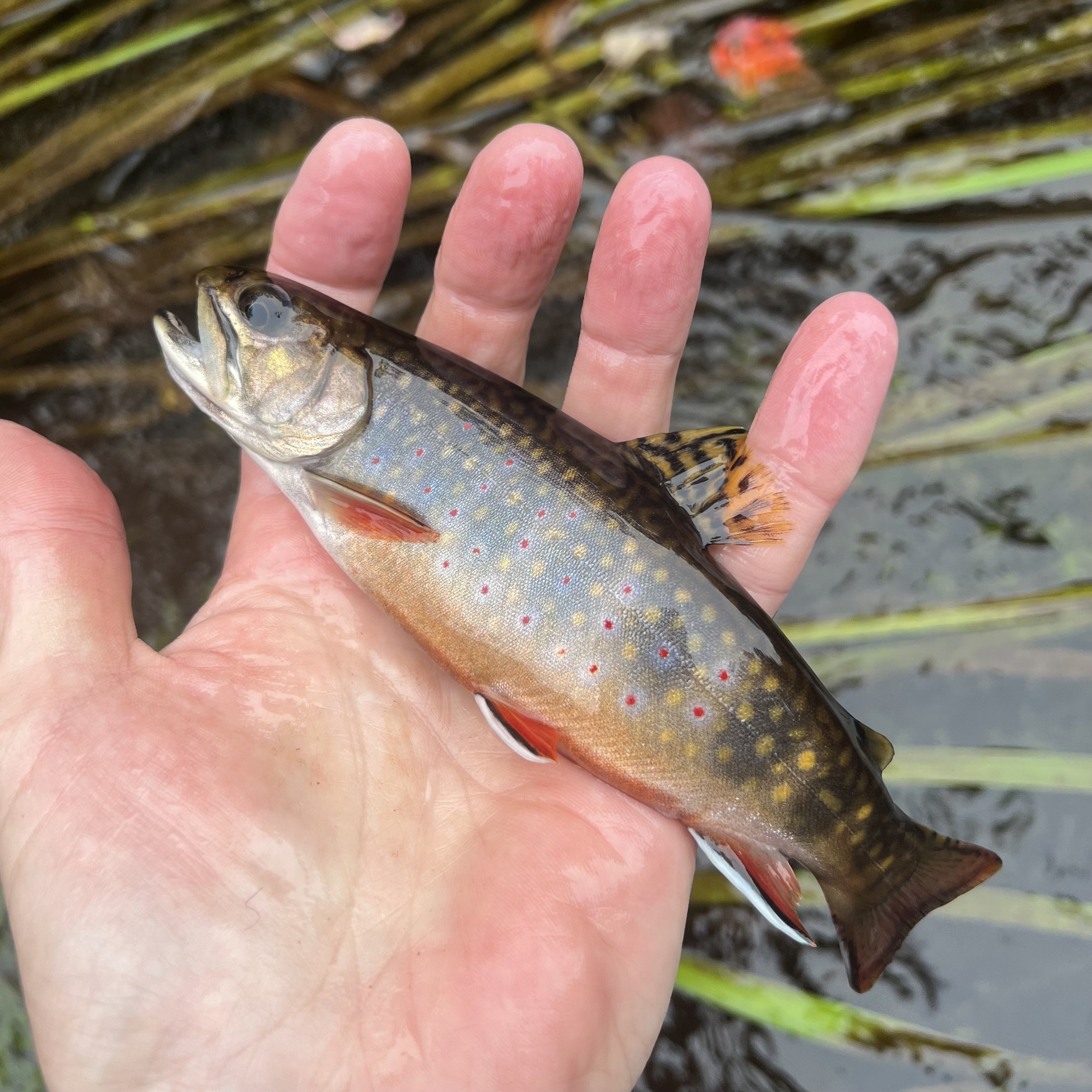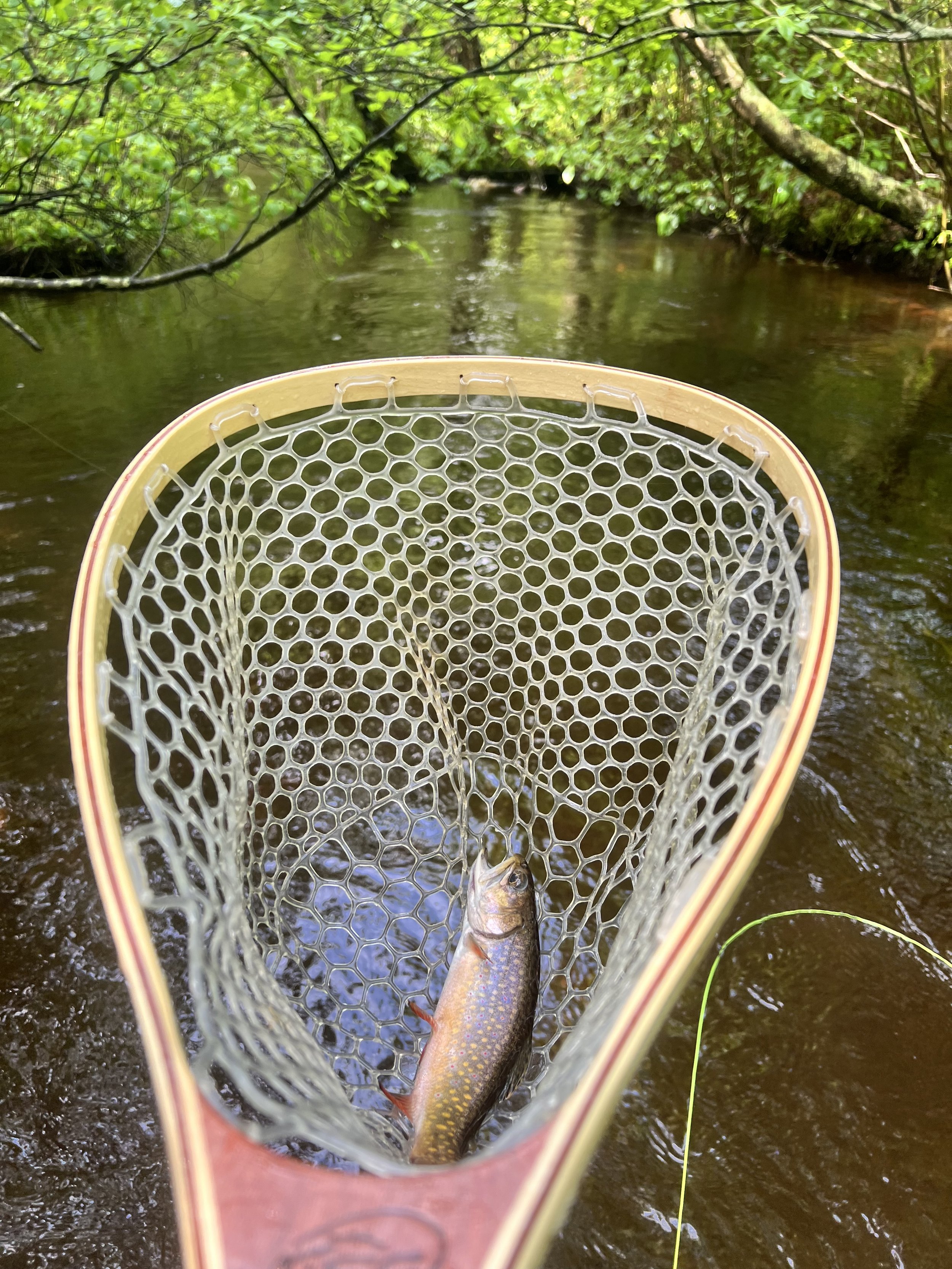Salters: Reclaiming Cape Cod
Comparison of a sea-run Brook Trout (Salvelinus fontinalis) in its silver, sea-run phase (top panel) and its more typical freshwater coloration, characterized by an olive green body with yellow and red dots and a yellow-red belly (bottom panel). Both trout were caught in the Quashnet River on Cape Cod.
Tucked into Cape Cod’s sandy soil and pine woods are cold, spring-fed streams—quiet, winding ribbons of water that once teemed with life. Among their most fascinating inhabitants is a fish both wild and rare: the sea-run Brook Trout (Salvelinus fontinalis), affectionately known as the "salter." Once abundant in coastal New England, these migratory trout have dwindled to just a shadow of their former numbers. But today, after centuries of decline, salters are making a comeback—thanks to dedicated conservation efforts, ecological restoration, and a growing community of people determined to see these fish thrive again.
Groundwater seeps that flow into these coastal streams as they run to the ocean, keeping the streams cool, even on the hottest summer day.
A Fish That Bridges Two Worlds
Brook Trout are a freshwater fish native to eastern North America and belong to the char genus—a group closely related to, but distinct from, true trout such as Rainbow and Brown Trout. Celebrated for their vivid colors, intricate vermiculations, and sensitivity to water quality, Brook Trout are enduring symbols of wild, coldwater ecosystems. While many populations spend their entire lives in rivers, streams, and lakes, Brook Trout display a range of life history strategies. In landlocked systems, individuals often inhabit lakes and migrate into tributary streams to spawn. In coastal regions like Cape Cod, some fish adopt a partial anadromous lifestyle. These sea-run Brook Trout, known as "salters," are born in cold, spring-fed headwaters and migrate downstream to brackish estuaries or nearshore marine waters to feed, before returning upstream to spawn in late fall. Although they move between freshwater and saltwater, salters are not considered fully anadromous like salmon; their migrations to the ocean are driven by foraging needs rather than reproduction. Historically, salters were widespread throughout Cape Cod’s coastal streams and estuaries, where they played a vital ecological role and were highly prized by some of America’s earliest sport anglers.
Small, but beautiful - most fish in these coastal streams seldom get larger than 8”. High rates of natural mortality results in few fish surviving older than 3 years in these systems.
A History of Habitat Loss
Over the centuries, Cape Cod’s rivers and streams have been shaped by the people who settled and lived on the land. In the early days, water-powered mills were essential for local economies, providing energy for sawing lumber, grinding grain, and supporting growing communities. Later, agriculture and cranberry farming took hold, with innovative water management practices that transformed wetlands and stream channels to support these uniquely Cape-based industries. As towns expanded and road networks were built, culverts and bridges helped knit together the region’s infrastructure—though often without consideration for fish passage or natural stream dynamics, which weren’t well understood at the time.
These changes, while vital to the Cape’s development and culture, gradually altered the natural flow and connectivity of rivers. Wetlands were filled or drained, stream channels were straightened or diverted, and many waterways became warmer and more fragmented. For native fish like sea-run Brook Trout, or salters, these changes posed serious challenges. Dams and undersized culverts created barriers to migration. Water withdrawals and modified flows affected the cold, clean conditions these fish depend on. Over time, many salter populations dwindled, with only a few hanging on in resilient pockets of intact habitat.
Brook Trout, whether landlocked or sea-run, are closely tied to their environment. They thrive in cool, oxygen-rich water and depend on healthy, well-connected streams to complete their life cycle. For salters, the journey from spring-fed freshwater headwaters to brackish estuaries and back again requires a continuous, unobstructed path. When even a single link in this corridor is disrupted—by a barrier, by warming waters, or by poor water quality—it can jeopardize their ability to survive and reproduce.
Today, with a growing awareness of these ecological connections, communities across the Cape are working to restore and reconnect streams—building on past knowledge and honoring both the natural and cultural heritage of the region.
A Brook Trout from a coastal stream on Cape Cod.
Why Salters Matter
Restoring sea-run Brook Trout is about more than just protecting a single fish—it’s about healing entire ecosystems. Brook Trout are often referred to as an “indicator species” because they rely on a precise set of environmental conditions: cold, clean, and well-connected water. When salters begin to reappear in a stream, it’s a strong signal that the broader system is functioning well. Their presence suggests that groundwater is flowing, riparian forests are healthy, and aquatic habitats are intact. And where Brook Trout thrive, other species tend to follow—river otters, amphibians, native insects, and migratory birds all benefit from the same clean, connected habitats.
But the value of these restored systems isn’t just ecological—it’s deeply personal and communal, too. Healthy trout streams help recharge aquifers that supply drinking water, buffer communities from flooding, and provide natural spaces where people can connect with the outdoors. For anglers, the chance to catch a wild Brook Trout in a coastal stream is both a rare thrill and a testament to successful conservation. For hikers, birdwatchers, and families exploring a woodland trail, these restored places offer quiet beauty and a glimpse into the natural rhythms that once defined life on the Cape.
There’s also something intangible but powerful about knowing that these wild fish still persist. That beneath a canopy of summer tree shade, under the shimmer of autumn leaves or in the soft light of spring rain, sea-run Brook Trout still make their home among us. Their resilience reminds us of the enduring connection between land, water, and wildlife—and of the role we can play in preserving that connection for generations to come.
A Brook Trout caught in the mid-section of the Quashnet River in a restored section of a former cranberry bog.
A Future for Wild Fish
While much progress has been made, the work of restoring sea-run Brook Trout and the streams they depend on is far from over. Climate change continues to raise stream temperatures and alter flow regimes. Development pressures can fragment habitat and increase runoff, while invasive species and disease threaten the balance of native ecosystems. Safeguarding the future of Cape Cod’s coldwater streams will require continued investment, strong partnerships, and the support of local communities who care deeply about these special places.
Fortunately, there are already powerful examples of what’s possible when people come together with a shared vision. On the lower Quashnet River in Falmouth, decades of restoration work have transformed a channelized former cranberry bog into one of the Cape’s healthiest coldwater streams. Volunteers and scientists have removed obstructions, re-meandered the stream, planted native vegetation, and monitored fish populations. Today, the Quashnet supports a naturally reproducing population of salters—and has become a model for stream restoration across the region. Restoration work continues on the upper Quashnet River.
Further east, the lower Coonamessett River has undergone a remarkable transformation of its own. Once heavily altered by cranberry farming and development, the river has been gradually reconnected to its floodplain through a series of collaborative projects led by the Town of Falmouth, local land trusts, and state agencies. Dam removals, wetland restoration, and the reestablishment of native plant communities have brought new life to the system—and new opportunities for fish, wildlife, and people alike. Similar to the Quashnet, restoration work is ongoing on the upper Coonamessett River.
A crew conducts and electrofishing survey of the Childs River on a recent fall morning, led by retired MassWildlife biologist, Steve Hurley.
The Childs River, which meanders through Mashpee and Falmouth, has seen significant recovery following years of restoration efforts aimed at reversing the impacts of channelization and habitat degradation. Once hindered by dams, culverts, and cranberry bogs, the river is now experiencing a more natural flow. Four years after a major restoration project, the river's hydrology has improved, fish passage has been enhanced, and vital habitats for Brook Trout and other native species have been restored. Monitoring results show promising signs: coldwater conditions are stable, native plant species are reemerging, and a self-sustaining population of Brook Trout now inhabit the restored sections.
These success stories are not the end—they’re just the beginning. New restoration efforts are taking shape across the region, including the upper Quashnet River, the headwaters of Red Brook, the upper reaches of the Mashpee River, and Fresh Brook in Wellfleet. These projects aim to heal critical stretches of Cape Cod’s rare coldwater coastal streams. By reconnecting fragmented habitats, removing barriers, and restoring natural flows, they hold the promise of even more resilient ecosystems—and more places for native fish like the salter Brook Trout to return and thrive.
These rivers remind us of what's possible with patience, collaboration, and a deep commitment to the places we love. Restoration doesn’t just benefit fish—it bolsters biodiversity, improves water quality, reduces flood risk, and helps people reconnect with the landscapes around them.
And if you listen closely—perhaps standing by the bank of a coastal stream at dawn—you might hear the soft splash of a Brook Trout rising, or catch a glimpse of its shadow darting beneath a log. These fish are living proof that with care, persistence, and shared stewardship, we can restore life to waters once written off—and ensure they remain vibrant for generations to come.













